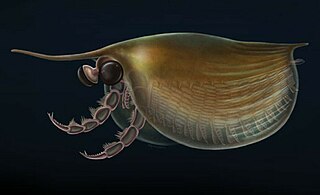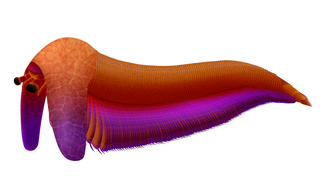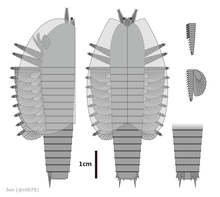
Marrella is an extinct genus of marrellomorph arthropod known from the middle Cambrian Burgess Shale of British Columbia. It is the most common animal represented in the Burgess Shale, with tens of thousands of specimens collected. Much rarer remains are also known from deposits in China.

Sidneyia is an extinct arthropod known from fossils found from the Early to the Mid Cambrian of China and the Mid Cambrian Burgess Shale of British Columbia, Canada.

Waptia is an extinct genus of arthropod from the Middle Cambrian of North America. It grew to a length of 6.65 cm (3 in), and had a large bivalved carapace and a segmented body terminating into a pair of tail flaps. It was an active swimmer and likely a predator of soft-bodied prey. It is also one of the oldest animals with direct evidence of brood care. Waptia fieldensis is the only species classified under the genus Waptia, and is known from the Burgess Shale Lagerstätte of British Columbia, Canada. Specimens of Waptia are also known from the Spence Shale of Utah, United States.

Odaraia is a genus of bivalved arthropod from the Middle Cambrian. Its fossils, which reach 15 centimetres (5.9 in) in length, have been found in the Burgess Shale in British Columbia, Canada.

Habelia is a genus of extinct arthropod from the Middle Cambrian, thought to be one of the earliest known relatives of chelicerates. Its fossils have been found in the Burgess Shale in British Columbia, Canada. Fifty-four specimens of Habelia are known from the Greater Phyllopod bed, where they comprise 0.1% of the community.
A number of assemblages bear fossil assemblages similar in character to that of the Burgess Shale. While many are also preserved in a similar fashion to the Burgess Shale, the term "Burgess Shale-type fauna" covers assemblages based on taxonomic criteria only.

Branchiocaris is an extinct genus of Cambrian bivalved arthropod. The type and best known species, Branchiocaris pretiosa, was described from the Burgess Shale of British Columbia, Canada, in 1929, originally placed in Protocaris, and was placed into its own distinct genus by Briggs in 1976. Several other possible species have been described from Cambrian deposits in China, and it is also possibly known from Cambrian deposits in Utah. Branchiocaris pretiosa is around 80–90 millimetres (3.1–3.5 in) in length, with a highly segmented trunk, consisting of at least 44 ring-like segments, terminating in a forked tail telson. At the front of the animal is a pair of short segmented tapered antennules with at least 20 segments, as well as a pair of claw appendages. It was likely an active swimmer, and used the claw appendages to bring food to the mouth.

Plenocaris plena is a Cambrian arthropod with a bivalved carapace, and is known from the Burgess shale and Chengjiang. Originally described as a species of Yohoia by Walcott in 1912, it was placed into its own genus in 1974.

Chuandianella ovata is an extinct bivalved arthropod that lived during Cambrian Stage 3 of the Early Cambrian. It is the only species classified under the genus Chuandianella. Its fossils were recovered from the Chengjiang Biota in Yunnan, China.

Clypecaris is genus of bivalved Cambrian arthropod known from the Chengjiang biota of Yunnan, China. The genus was initially described for the type species C. pteroidea by Hou, 1999. A second species C. serrata was described by Yang et al. in 2016. The species are primarily distinguished by the presence of a serrated edge on the front of the carapace of C. serrata. C. serrata is noted for the modification of an anterior pair of limbs into spined grasping appendages, indicating a predatory lifestyle. It is unknown whether a similar structure was present in C. pteroidea.Clypecaris is considered to likely be a member or a close relative of Hymenocarina, and is closely related to Perspicaris. As well as to Ercaicunia.

Ercaicunia is genus of bivalved Cambrian arthropod from the Chengjiang biota of Yunnan, China. It contains a single species, E. multinodosa that was described by Luo et al. in 1999. The total length of the body ranges from 8 to 11 millimetres. The bivalved carapace covered about a third of the total body-length, and has up to six serrations on its forward edge. The head has a pair of large uniramous antennae, as well as a smaller pair of secondary antennae, as well as pair of mandibles and maxillae. The trunk has 16 pairs of biramous appendages. Specimens were CT scanned in 2019, which suggested it to be a stem-group crustacean. Other subsequent studies have recovered it as a member of Hymenocarina, which contains other bivalved Cambrian arthropods.

Haikoucaris is a genus of megacheiran arthropod that contains the single species Haikoucaris ercaiensis. It was discovered in the Cambrian Chengjiang biota of China.

Isoxys is a genus of extinct bivalved Cambrian arthropod; the various species of which are thought to have been freely swimming predators. It had a pair of large spherical eyes, and two large frontal appendages used to grasp prey.

Pectocaris is an extinct genus of bivalved arthropods from the Cambrian Maotianshan Shales, Yunnan Province of China. There are currently three known species within the genus.

Tokummia is a genus of fossil hymenocarine arthropod, known only by one species, Tokummiakatalepsis, from the middle Cambrian Burgess Shale as found in a quarry in Marble Canyon in Canada.

Hymenocarina is an order of extinct arthropods known from the Cambrian. They possess bivalved carapaces, typically with exposed posteriors. Members of the group are morphologically diverse and had a variety of ecologies, including as filter feeders and as predators. Recent research has generally considered them to be stem or crown group members of Mandibulata, due the presence of mandibles in at least some species.

Balhuticaris is a genus of extinct bivalved hymenocarine arthropod that lived in the Cambrian aged Burgess Shale in what is now British Columbia around 506 million years ago. This extremely multisegmented arthropod is the largest member of the group, and it was even one of the largest animals of the Cambrian, with individuals reaching lengths of 245 mm (9 in). Fossils of this animal suggests that gigantism occurred in more groups of Arthropoda than had been previously thought. It also presents the possibility that bivalved arthropods were very diverse, and filled in a lot of ecological niches.

Jugatacaris is an extinct genus of bivalved arthropod known from a single species, Jugatacaris agilis found in the Cambrian Stage 3 aged Chengjiang biota of Yunnan, China. The carapace is around 28 to 37 millimetres in length, with a pronounced ridge at the top of the carapace separating the two valves, which formed a fin-like structure raised above the carapace. The head has a pair of stalked eyes, as well as a dumbbell shaped medial eye between them. The head also bore a pair of mandibles as well as at least one and possibly two pairs of antennules. The trunk had up to 65 segments, each with biramous appendages. The appendages had thin endopods with 30 podomeres, each bearing a spiny endite, with the endopods ending with a terminal claw. The appendages also had overlapping flap-like exopods, which are elongated, being at maximum eight times as long as they are wide, which on their posterior edge are covered with setae. The trunk ended with a forked tail. It was likely an actively swimming filter feeder, using its constantly beating appendages to sift food from the water column, which was then passed forward along the U-shaped food groove between the appendage pairs towards the mouth. While initially placed as a crustaceanomorph, later studies considered to be a member of Hymenocarina, which contains numerous other similar bivalved Cambrian arthropods.

Surusicaris is an extinct genus of bivalved arthropod, known from the Cambrian Burgess Shale of British Columbia, Canada. It is considered to be closely related to Isoxys, and like it has spined grasping frontal appendages.

Isoxyids are members of the order Isoxyida and the family Isoxyidae, a group of basal arthropods that existed during the Cambrian period. It contains two genera, Isoxys, with 20 species found worldwide, and Surusicaris known from a single species found in the Burgess Shale of Canada. They are distinguished by their bivalved carapaces and pair of upward curving grasping frontal appendages.






















